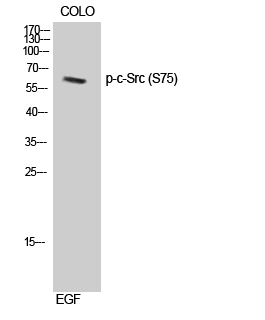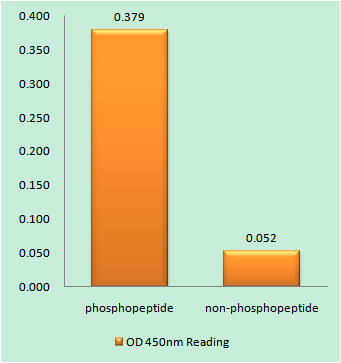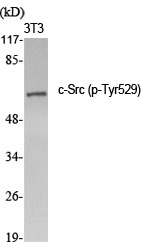
Catalog: YM8399
Size
Price
Status
Qty.
200μL
$600.00
In stock
0
100μL
$340.00
In stock
0
40μL
$190.00
In stock
0
Add to cart


Collected


Collect
Main Information
Target
c-Src
Host Species
Rabbit
Reactivity
Human, Mouse, Rat,
Applications
WB, IHC, IF, IP, ELISA
MW
60kD (Calculated)
60kD (Observed)
Conjugate/Modification
Unmodified
Detailed Information
Recommended Dilution Ratio
IHC 1:1000-1:4000; WB 1:2000-1:10000; IF 1:200-1:1000; ELISA 1:5000-1:20000; IP 1:50-1:200;
Formulation
PBS, 50% glycerol, 0.05% Proclin 300, 0.05%BSA
Specificity
Endogenous
Purification
Protein A
Storage
-15°C to -25°C/1 year(Do not lower than -25°C)
MW(Calculated)
60kD
MW(Observed)
60kD
Modification
Unmodified
Clonality
Monoclonal
Clone Number
PT0588R
Isotype
IgG,Kappa
Related Products
Antigen&Target Information
Specificity:
Endogenous
show all
Gene Name:
SRC SRC1
show all
Protein Name:
Src
show all
Other Name:
Proto-oncogene tyrosine-protein kinase Src ;
Proto-oncogene c-Src ;
pp60c-src ;
p60-Src ;
Proto-oncogene c-Src ;
pp60c-src ;
p60-Src ;
show all
Background:
This gene is highly similar to the v-src gene of Rous sarcoma virus. This proto-oncogene may play a role in the regulation of embryonic development and cell growth. The protein encoded by this gene is a tyrosine-protein kinase whose activity can be inhibited by phosphorylation by c-SRC kinase. Mutations in this gene could be involved in the malignant progression of colon cancer. Two transcript variants encoding the same protein have been found for this gene. [provided by RefSeq, Jul 2008],
show all
Function:
Catalytic activity:ATP + a [protein]-L-tyrosine = ADP + a [protein]-L-tyrosine phosphate.,PTM:Phosphorylated on Tyr-530 by c-Src kinase (CSK). The phosphorylated form is termed pp60c-src. The phosphorylated tail interacts with the SH2 domain thereby repressing kinase activity.,similarity:Belongs to the protein kinase superfamily. Tyr protein kinase family. SRC subfamily.,similarity:Contains 1 protein kinase domain.,similarity:Contains 1 SH2 domain.,similarity:Contains 1 SH3 domain.,subunit:Interacts with DDEF1/ASAP1; via the SH3 domain. Interacts with CCPG1 (By similarity). Interacts with CDCP1, PELP1, TGFB1I1 and TOM1L2. Interacts with the cytoplasmic domain of MUC1, phosphorylates it and increases binding of MUC1 with beta-catenin. Interacts with RALGPS1; via the SH3 domain. Interacts with HEV ORF3 protein; via the SH3 domain.,
show all
Cellular Localization:
Cytoplasm, Nucleus
show all
Tissue Expression:
Expressed ubiquitously. Platelets, neurons and osteoclasts express 5-fold to 200-fold higher levels than most other tissues.; [Isoform 1]: Expressed in spleen and liver. ; [Isoform 2]: Expressed in brain. ; [Isoform 3]: Expressed in brain.
show all
Research Areas:
>>EGFR tyrosine kinase inhibitor resistance ;
>>Endocrine resistance ;
>>ErbB signaling pathway ;
>>Rap1 signaling pathway ;
>>Chemokine signaling pathway ;
>>Mitophagy - animal ;
>>Endocytosis ;
>>Axon guidance ;
>>VEGF signaling pathway ;
>>Focal adhesion ;
>>Adherens junction ;
>>Tight junction ;
>>Gap junction ;
>>Platelet activation ;
>>Neutrophil extracellular trap formation ;
>>C-type lectin receptor signaling pathway ;
>>GABAergic synapse ;
>>Inflammatory mediator regulation of TRP channels ;
>>Regulation of actin cytoskeleton ;
>>GnRH signaling pathway ;
>>Estrogen signaling pathway ;
>>Prolactin signaling pathway ;
>>Thyroid hormone signaling pathway ;
>>Oxytocin signaling pathway ;
>>Relaxin signaling pathway ;
>>Bacterial invasion of epithelial cells ;
>>Epithelial cell signaling in Helicobacter pylori infection ;
>>Pathogenic Escherichia coli infection ;
>>Shigellosis ;
>>Yersinia infection ;
>>Tuberculosis ;
>>Hepatitis B ;
>>Human cytomegalovirus infection ;
>>Kaposi sarcoma-associated herpesvirus infection ;
>>Herpes simplex virus 1 infection ;
>>Viral carcinogenesis ;
>>Proteoglycans in cancer ;
>>Chemical carcinogenesis - receptor activation ;
>>Chemical carcinogenesis - reactive oxygen species ;
>>Bladder cancer ;
>>Lipid and atherosclerosis ;
>>Fluid shear stress and atherosclerosis
>>Endocrine resistance ;
>>ErbB signaling pathway ;
>>Rap1 signaling pathway ;
>>Chemokine signaling pathway ;
>>Mitophagy - animal ;
>>Endocytosis ;
>>Axon guidance ;
>>VEGF signaling pathway ;
>>Focal adhesion ;
>>Adherens junction ;
>>Tight junction ;
>>Gap junction ;
>>Platelet activation ;
>>Neutrophil extracellular trap formation ;
>>C-type lectin receptor signaling pathway ;
>>GABAergic synapse ;
>>Inflammatory mediator regulation of TRP channels ;
>>Regulation of actin cytoskeleton ;
>>GnRH signaling pathway ;
>>Estrogen signaling pathway ;
>>Prolactin signaling pathway ;
>>Thyroid hormone signaling pathway ;
>>Oxytocin signaling pathway ;
>>Relaxin signaling pathway ;
>>Bacterial invasion of epithelial cells ;
>>Epithelial cell signaling in Helicobacter pylori infection ;
>>Pathogenic Escherichia coli infection ;
>>Shigellosis ;
>>Yersinia infection ;
>>Tuberculosis ;
>>Hepatitis B ;
>>Human cytomegalovirus infection ;
>>Kaposi sarcoma-associated herpesvirus infection ;
>>Herpes simplex virus 1 infection ;
>>Viral carcinogenesis ;
>>Proteoglycans in cancer ;
>>Chemical carcinogenesis - receptor activation ;
>>Chemical carcinogenesis - reactive oxygen species ;
>>Bladder cancer ;
>>Lipid and atherosclerosis ;
>>Fluid shear stress and atherosclerosis
show all
Signaling Pathway
Cellular Processes >> Transport and catabolism >> Mitophagy - animal
Cellular Processes >> Cellular community - eukaryotes >> Focal adhesion
Cellular Processes >> Cellular community - eukaryotes >> Adherens junction
Cellular Processes >> Cellular community - eukaryotes >> Tight junction
Cellular Processes >> Cellular community - eukaryotes >> Gap junction
Cellular Processes >> Cell motility >> Regulation of actin cytoskeleton
Organismal Systems >> Immune system >> Platelet activation
Organismal Systems >> Immune system >> Neutrophil extracellular trap formation
Organismal Systems >> Immune system >> Chemokine signaling pathway
Organismal Systems >> Endocrine system >> GnRH signaling pathway
Organismal Systems >> Endocrine system >> Estrogen signaling pathway
Organismal Systems >> Endocrine system >> Prolactin signaling pathway
Organismal Systems >> Endocrine system >> Oxytocin signaling pathway
Organismal Systems >> Endocrine system >> Relaxin signaling pathway
Organismal Systems >> Endocrine system >> Thyroid hormone signaling pathway
Organismal Systems >> Sensory system >> Inflammatory mediator regulation of TRP channels
Human Diseases >> Cancer: specific types >> Bladder cancer
Environmental Information Processing >> Signal transduction >> ErbB signaling pathway
Environmental Information Processing >> Signal transduction >> Rap1 signaling pathway
Environmental Information Processing >> Signal transduction >> VEGF signaling pathway
Reference Citation({{totalcount}})
Catalog: YM8399
Size
Price
Status
Qty.
200μL
$600.00
In stock
0
100μL
$340.00
In stock
0
40μL
$190.00
In stock
0
Add to cart


Collected


Collect
Recently Viewed Products
Clear allPRODUCTS
CUSTOMIZED
ABOUT US
Toggle night Mode
{{pinfoXq.title || ''}}
Catalog: {{pinfoXq.catalog || ''}}
Filter:
All
{{item.name}}
{{pinfo.title}}
-{{pinfo.catalog}}
Main Information
Target
{{pinfo.target}}
Reactivity
{{pinfo.react}}
Applications
{{pinfo.applicat}}
Conjugate/Modification
{{pinfo.coupling}}/{{pinfo.modific}}
MW (kDa)
{{pinfo.mwcalc}}
Host Species
{{pinfo.hostspec}}
Isotype
{{pinfo.isotype}}
Product {{index}}/{{pcount}}
Prev
Next
{{pvTitle}}
Scroll wheel zooms the picture
{{pvDescr}}















.jpg)







